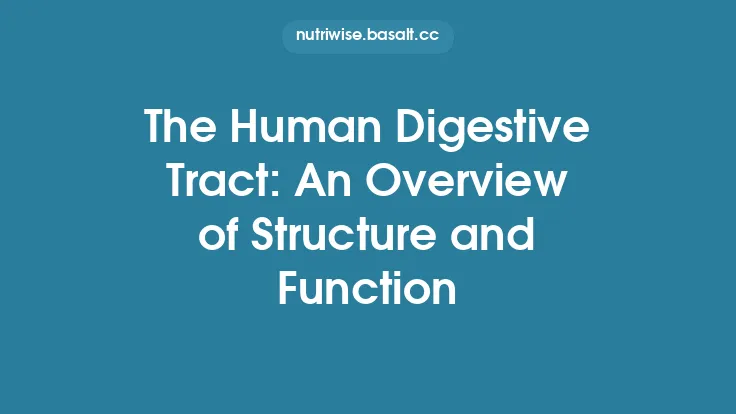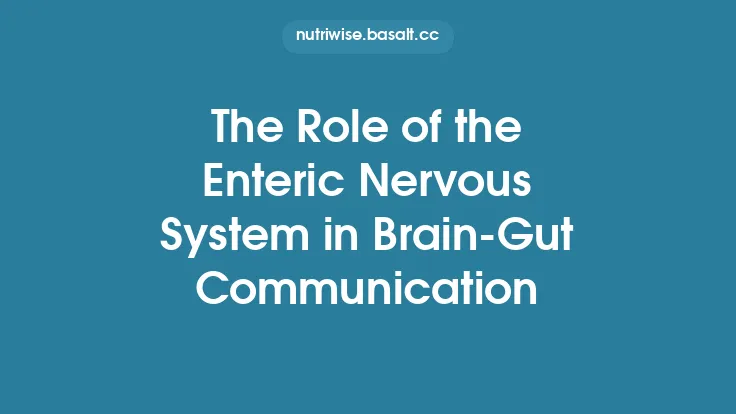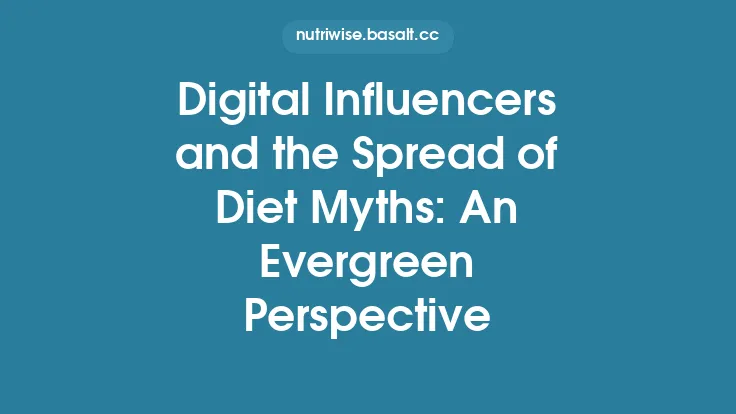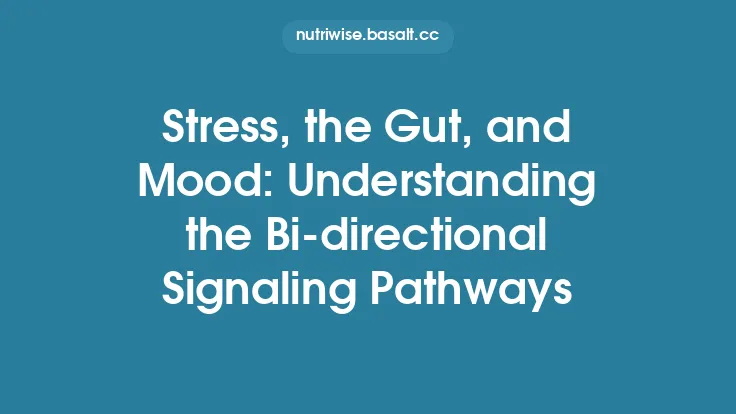The vagus nerve—cranial nerve X—is the principal conduit linking the gastrointestinal (GI) tract with the central nervous system (CNS). Its unique anatomy, bidirectional signaling capacity, and integration with autonomic, endocrine, and immune networks make it the cornerstone of the gut‑brain axis. Understanding how the vagus nerve gathers information from the gut, relays it to the brain, and then modulates digestive physiology provides a timeless framework for anyone interested in the physiology of digestion, neurobiology, or integrative health.
Anatomical Overview of the Vagus Nerve
The vagus nerve is the longest cranial nerve, extending from the medulla oblongata to the abdomen. It is composed of roughly 80–90 % afferent (sensory) fibers and 10–20 % efferent (motor) fibers, reflecting its primary role as a sensory highway. The nerve originates in two brainstem nuclei:
- Nucleus Tractus Solitarius (NTS) – the primary sensory relay for visceral afferents.
- Dorsal Motor Nucleus of the Vagus (DMV) – the source of parasympathetic efferents that innervate the GI tract, heart, and lungs.
From the brainstem, the vagus descends within the carotid sheath, giving off branches that innervate the pharynx, larynx, and thoracic organs before reaching the abdominal cavity. In the abdomen, the cervical, thoracic, and abdominal vagal trunks split into anterior (ventral) and posterior (dorsal) vagal trunks, which then give rise to a dense plexus of fibers that surround the esophagus, stomach, small intestine, and proximal colon. These fibers form the vagal plexus (or vagal nerve network) that directly contacts the gut wall through:
- Intramural vagal afferents that terminate in the lamina propria and muscular layers.
- Vagal efferents that travel within the myenteric and submucosal plexuses, influencing smooth muscle, glands, and blood vessels.
The vagus is also richly supplied with glial cells (enteric glia) and immune cells that modulate its activity, creating a microenvironment that can be altered by infection, inflammation, or metabolic changes.
Afferent Pathways: Sensing the Gut Environment
1. Mechanoreceptors
Vagal afferents contain stretch‑sensitive mechanoreceptors that monitor the distension of the stomach and intestines. When a meal enters the stomach, the resulting expansion activates intramuscular arrays (IMAs) and intraganglionic laminar endings (IGLEs), generating action potentials that travel centrally. These signals inform the brain about gastric volume, contributing to the sensation of fullness and regulating the timing of subsequent gastric emptying.
2. Chemoreceptors
Beyond mechanical stretch, vagal afferents detect chemical cues such as pH, osmolarity, and nutrient composition. Specialized chemosensory endings in the mucosa respond to:
- Acidic or alkaline luminal contents – influencing gastric acid secretion via reflex pathways.
- Nutrient‑derived metabolites – such as short‑chain fatty acids (SCFAs) and bile acids, which can activate G‑protein‑coupled receptors (e.g., GPR41/43) on vagal terminals, modulating afferent firing rates.
These chemosensory signals are transmitted without relying on the classic satiety hormones (e.g., ghrelin, CCK) that are covered elsewhere, emphasizing the direct sensory capacity of the vagus.
3. Immunological Sensors
Vagal afferents are equipped with toll‑like receptors (TLRs) and other pattern‑recognition receptors that detect microbial components (e.g., lipopolysaccharide). Activation of these receptors can trigger vagal afferent signaling that informs the CNS of gut‑derived immune challenges, initiating systemic anti‑inflammatory responses.
Central Processing: From the Nucleus Tractus Solitarius to Higher Brain Centers
All vagal afferent fibers converge on the NTS, located in the dorsal medulla. Within the NTS, afferent inputs are sorted and integrated with signals from other visceral afferents (e.g., glossopharyngeal, spinal). The NTS then projects to several key brain regions:
- Parabrachial nucleus (PBN) – relays visceral information to the thalamus and limbic structures.
- Hypothalamus – particularly the paraventricular nucleus (PVN), where vagal input influences autonomic output and neuroendocrine release.
- Insular cortex and orbitofrontal cortex – areas implicated in interoceptive awareness and decision‑making about food intake.
- Amygdala and hippocampus – providing a route for gut‑derived signals to affect emotional memory and stress reactivity (though the article avoids deep discussion of mood pathways).
The NTS also communicates directly with the DMV, forming a short‑loop reflex that can instantly adjust vagal efferent output based on incoming sensory information. This rapid feedback system underlies many of the reflexes that coordinate digestion.
Efferent Pathways: Vagal Control of Gastrointestinal Function
Vagal efferents arise from the DMV and travel back to the gut, where they release acetylcholine (ACh) onto target cells. Their actions can be grouped into three major functional domains:
1. Motor Regulation
- Gastric motility – ACh stimulates smooth‑muscle contraction via muscarinic receptors (M₃), promoting peristalsis and coordinated mixing of gastric contents.
- Intestinal transit – Vagal efferents enhance the rhythmic contractions of the small intestine, facilitating nutrient absorption.
2. Secretory Modulation
- Gastric acid and pepsinogen – Vagal stimulation of parietal and chief cells increases secretion, preparing the lumen for protein digestion.
- Pancreatic exocrine secretion – Through the pancreaticoduodenal branch, vagal efferents trigger the release of digestive enzymes and bicarbonate.
- Mucosal blood flow – ACh-mediated vasodilation improves nutrient delivery and waste removal.
3. Immune and Anti‑Inflammatory Actions
Vagal efferents innervate splenic and gut‑associated lymphoid tissue. The release of ACh onto α7 nicotinic acetylcholine receptors (α7nAChR) on macrophages suppresses pro‑inflammatory cytokine production—a mechanism known as the cholinergic anti‑inflammatory pathway. This reflex arc enables the brain to dampen excessive gut inflammation via vagal output.
The Vagus Nerve and Immune Modulation
Beyond its direct motor and secretory roles, the vagus nerve serves as a neuroimmune interface. Two complementary pathways illustrate this function:
- The “Inflammatory Reflex” – Sensory detection of peripheral inflammation (e.g., bacterial translocation) triggers afferent signaling to the NTS, which then activates efferent vagal fibers. The resulting ACh release in the gut and spleen curtails cytokine release (TNF‑α, IL‑1β, IL‑6), protecting tissues from damage.
- Enteric Glial‑Vagal Crosstalk – Enteric glial cells release S100β and other neurotrophic factors that modulate vagal excitability. In turn, vagal activity influences glial calcium signaling, creating a bidirectional loop that fine‑tunes immune surveillance.
These mechanisms are independent of the classic gut hormones and underscore the vagus nerve’s capacity to integrate metabolic, mechanical, and immunological information.
Vagal Reflex Arcs: The Gut‑Brain‑Vagus Loop
The gut‑brain‑vagus loop can be conceptualized as a series of reflex arcs that maintain homeostasis:
- Sensory Input – Mechanical stretch, chemical composition, and immune signals are detected by vagal afferents.
- Central Integration – The NTS processes the input and coordinates with hypothalamic and limbic nuclei.
- Motor Output – The DMV dispatches efferent signals that adjust motility, secretion, and immune tone.
- Feedback – Changes in gastric emptying, enzyme release, or inflammatory status are sensed anew by afferents, completing the loop.
Because the loop operates continuously, it provides an evergreen regulatory system that adapts to daily variations in diet, activity, and health status without requiring conscious oversight.
Clinical Implications and Therapeutic Applications
1. Vagus Nerve Stimulation (VNS)
- Implantable VNS – Originally approved for refractory epilepsy, VNS has demonstrated benefits in treatment‑resistant depression, inflammatory bowel disease (IBD), and post‑operative ileus. The therapeutic effect is thought to arise from enhanced cholinergic anti‑inflammatory signaling and modulation of gut motility.
- Transcutaneous VNS (tVNS) – Non‑invasive stimulation of the auricular branch offers a convenient method to engage vagal pathways. Early trials suggest improvements in gastric emptying rates and visceral pain thresholds.
2. Diagnostic Use of Vagal Function
- Heart‑Rate Variability (HRV) – As a surrogate for vagal tone, HRV analysis can indicate autonomic balance and predict gastrointestinal dysmotility.
- Vagal Evoked Potentials (VEPs) – Recording afferent responses to gastric distension provides a direct measure of sensory integrity, useful in conditions such as functional dyspepsia.
3. Pathophysiological Conditions Linked to Vagal Dysfunction
- Gastroparesis – Reduced vagal efferent activity leads to delayed gastric emptying; VNS is being explored as a therapeutic avenue.
- Irritable Bowel Syndrome (IBS) – Altered vagal afferent signaling may contribute to dysregulated motility and visceral hypersensitivity.
- Neurodegenerative Disorders – In Parkinson’s disease, early vagal degeneration is hypothesized to precede central pathology, highlighting the vagus as a potential early biomarker.
Research Techniques for Studying Vagal Gut‑Brain Communication
| Technique | What It Measures | Typical Application |
|---|---|---|
| Electrophysiology (in vivo nerve recordings) | Action potential frequency in afferent/efferent fibers | Mapping response to gastric distension or nutrient infusion |
| Optogenetics | Light‑controlled activation/inhibition of specific vagal neuron populations | Dissecting causal roles of distinct vagal sub‑circuits |
| Chemogenetics (DREADDs) | Designer receptors activated by synthetic ligands | Long‑term modulation of vagal tone in behavioral studies |
| Functional MRI (fMRI) with gastric balloon | Brain activation patterns in response to controlled gastric stretch | Identifying central processing hubs |
| Transgenic reporter mice (e.g., Phox2b‑Cre) | Visualization of vagal neuronal projections | Anatomical mapping of vagal innervation |
| Microdialysis of gut interstitial fluid | Local neurotransmitter and cytokine concentrations | Correlating vagal activity with local chemical milieu |
These tools enable researchers to parse the complex, multi‑level interactions that define the vagus‑mediated gut‑brain axis, ensuring that findings remain relevant across decades.
Future Directions and Emerging Questions
- Molecular Phenotyping of Vagal Subtypes – Single‑cell RNA sequencing is beginning to reveal distinct molecular signatures among vagal afferents (e.g., mechanosensitive vs. chemosensitive). Understanding these subpopulations could allow targeted therapies that modulate only the relevant pathways.
- Vagal Plasticity in Aging – Age‑related decline in vagal tone correlates with slower gastric emptying and increased inflammation. Investigating whether lifestyle interventions or pharmacologic agents can restore vagal plasticity may have broad implications for healthy aging.
- Cross‑Talk with the Microbiome – While not the focus of this article, emerging data suggest that microbial metabolites can directly influence vagal excitability. Deciphering the precise receptors and signaling cascades will clarify how diet‑induced microbiome changes translate into neural signals.
- Integration with Central Neuromodulatory Systems – The vagus interacts with serotonergic, dopaminergic, and noradrenergic pathways that regulate reward and motivation. Mapping these intersections could explain why certain GI disorders co‑occur with neuropsychiatric conditions.
- Personalized VNS Protocols – Advances in closed‑loop stimulation—where real‑time physiological data (e.g., HRV, gastric pressure) guide VNS intensity—promise more precise modulation of the gut‑brain axis tailored to individual needs.
In sum, the vagus nerve stands as the central highway of the gut‑brain axis, translating mechanical, chemical, and immunological information from the digestive tract into neural codes that the brain can interpret and act upon. Its bidirectional nature ensures that the brain can, in turn, fine‑tune digestive processes, maintain immune balance, and preserve overall homeostasis. By appreciating the timeless principles of vagal anatomy, signaling, and reflex organization, we gain a durable framework that supports both basic scientific inquiry and the development of innovative clinical interventions.





